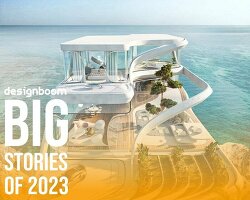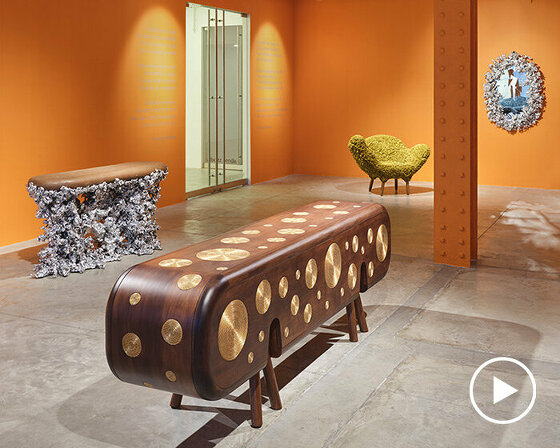spotlighting 2023’s top 10 social impact stories
Continuing our annual roundup of 2023’s most impactful initiatives, designboom spotlights the diverse ways in which artists, designers, and architects have utilized their crafts as tools to initiate positive social change. This year, the creative landscape has increasingly focused on exploration of the profound impact design can have on the world. We have seen architects crafting spatial solutions in underprivileged regions to make education more accessible or to house displaced communities, while designers have created installations that invite interaction and poignantly illuminate the impacts of climate change and overconsumption on our ecosystems. Notably, these projects are rooted in their context, either drawing on nuances of heritage, or integrating with their site-specific locations. Read on as we spotlight our TOP 10 most thought-provoking stories dedicated to social impact submitted by our readers.
DISASTER-PROOF ‘BRIDGE SCHOOLS’ IN CYCLONE-PRONE BANGLADESH PROVIDE ACCESSIBLE EDUCATION

image courtesy of Quazi Wafiq Alam
The Bridge Schools initiative seeks to empower disadvantaged communities in Bangladesh by making education more accessible to children along coastal, disaster-prone regions. The project led by Quazi Wafiq Alam alongside a group of architects introduces community-based participatory design development workshops where school dropout children alongside parents and peers can engage in academic and extracurricular growth activities.
The schools are built across eight locations with protective frameworks comprising reinforced concrete columns and beams in a simple grid to ensure protective longevity and rigidity in the cyclone-prone areas. In their designs, they are modular and uniform, enveloped in vibrantly painted wooden panels to create an engaging and playful learning environment.
read more here
STUDIO BYCOLOR DECONSTRUCTS SEAWEED PIGMENT TO CRAFT COTTON, SILK, AND WOOL TILES

image courtesy of STUDIO BYCOLOR
Exploring an intricate interplay between colors and materiality, STUDIO BYCOLOR presents NORI PIGMENT: Pigment from the Sea. The project delves into the deep black hues of seaweed, deconstructing its beauty while unravelling the essence of seaweed itself through the lens of pigment exploration. Red algae, a fundamental pigment in nori, plays a critical role in nutrient acquisition for seaweed in the ocean. To visually capture the concealed red hues within the black laver, the studio has created panels and tiles utilizing cotton, silk, wool, and traditional Japanese paper-making techniques. Led by Kaori Akiyama, soil from Mino, Japan, has been filtered through unglazed clay to the same size as seaweed. Just as the seaweed can be cut into various pieces for consumption, the dyed patterns reflect the diversity of its preparation, ranging from two to twelve pieces.
read more here
HUMANITARIA’S BIODEGRADABLE CARDBOARD BEDS ASSEMBLE IN FIVE SECONDS FOR EMERGENCY RELIEF

image courtesy of Humanitaria
Accelerated by the UNICEF Lab program, start-up Humanitaria has introduced a time-efficient and economic cardboard bed designed to provide relief for humanitarian emergencies. Boasting a five second assembly time without the need for any tools and costing only a fraction of traditional alternatives, the bed is 100% recyclable and biodegradable, and ensures immediate aid within the first 24 hours of an emergency — the threshold that makes the difference between the success or failure of an operation.
With it, Humanitaria applies for the first time the concepts of specialization and super-efficiency to humanitarian equipment, the daily tool of social sector organizations, and one of the biggest expenses that every NGO faces annually, exceeding 40% of their annual budget. The initial deployment of the beds will be tested in upcoming rescue operations organized by Catalunya’s Red Cross this autumn, as the team continues to produce up to 24,000 units per day.
read more here
POWERED BY MYCELIUM, MYCOTEMPLE DOME BIODEGRADES TO NOURISH THE EARTH

image by Gian-Battista Lombardo
Spirituality and sustainable innovation converge in Côme Di Meglio’s transformative living sanctuary — MycoTemple. This five-meter-wide domed structure harnesses the power of mycelium to grow temples, sheltering a space for physical and spiritual transformation. While the organism forms the structure’s primary construction material, a hand-carved wooden structure is hidden within, revealed only as the mycelium gradually biodegrades over time and returns to fertilize the soil from which it came.
Beyond its artistic and architectural appeal, the space has been realized to foster a diverse range collective experiences and communal events, including gatherings, concerts, and quiet moments of contemplation. ‘All the emotions and dreams birthed in the dome will nurture this porous material,’ notes Di Meglio.
read more here
RONALD VAN DER MEIJS’ DROP-SHAPED INSTALLATION IN DUTCH FOREST RETURNS TAP WATER TO NATURE

image courtesy of Ronald van der Meijs
Following the combined effects of climate change, excessive human water consumption, and the raised demands of drinking water suppliers, Ronald van der Meijs’ sculpture sits in the Utrechtse Heuvelrug nature reserve as a symbol of hope. Against this backdrop, low groundwater levels in Dutch forests have led to severe drought, impacting the natural environment and its resources. In response, ‘H2O I will give it back to you every day’ is an art installation that connects to Zeist’s water supply network, retrieving up to 130 liters, and returning it to sustain the natural landscape each day.
read more here
FORM FOUND DESIGN’S PREFABRICATED STEEL HOMES PROVIDE RELIEF FOR DISPLACED FAMILIES IN ARMENIA

image courtesy of Form Found Design
Los Angeles-based architectural firm Form Found Design has completed a humanitarian housing project in Yerevan, Armenia, aiding impoverished families displaced by flooding. Equipped with solar panels and solar water heating systems, the Home of Hope showcases the realization of mass-customization using Light Gauge Steel, achieved by employing the FrameCAD software-to-machine-workflow (CAD-CAM).
Form Found Design’s President, Joseph Sarafian, also a Professor of Architecture at Orange Coast College, led an exploration of alternative materials and technologies. Though originally sought for its expertise in robotic concrete casting to aid in 3D-printing concrete housing, the studio instead identified how light gauge steel could serve the immediate need for housing. This material, augmented by the capabilities of a FrameCAD Machine, presented an avenue for rapid design and production of houses or other building types through a proprietary software-to-fabrication pipeline. This technology streamlines the process by unrolling steel coils and transforming them into custom-sized studs.
read more here
LAURA MARIA GONZALEZ CULTIVATES SUSTAINABLE BIOCEMENT FROM MICROBES FOR EXHIBITION AT MIT

image courtesy of Laura Maria Gonzalez
In Laura Maria Gonzalez’s exhibition Microbes Make Mountains, the researcher and designer sheds light on Earth’s tiniest architects — microbes — whose silent work has been shaping our ecosystems for billions of years. On display at MIT’s Keller Gallery, this showcase delves into the intersection of design and microbial life, unveiling the hidden artistry of these ancient communities and their potential to influence design concepts. As Gonzalez showcases the potential for these lifeforms to influence design concepts, she provides a fresh perspective on the intricate dance of life and geology, prompting us to reimagine how we build and live.
The installations draw inspiration from the vibrant mineral formations found in places such as Spain’s Rio Tinto and Ethiopia’s Danakil Depression, where microbial communities significantly contribute to the creation of striking mineral patterns. Building upon this, Gonzalez showcases the potential of bacteria to create biocement, a sustainable alternative to traditional concrete which is produced through a delicate act of cultivation and creation.
read more here
PORTABLE AND DURABLE PEDIATRIC MONITORING SYSTEM ENHANCES HEALTHCARE ACCESS IN AFRICA

image courtesy of ManGo Product Design
Born from a collaboration between GOAL 3, ManGo Product Design, and Amref Flying Doctors, the IMPALA health monitor has been developed to transform pediatric healthcare in low and middle-income countries. This affordable monitoring system has already achieved optimal results during its pilot implementation at St. Luke’s Hospital in Malawi, with a 61.7% reduction in baby mortality and a 26% reduction in admission time, revolutionizing healthcare access in Africa.
In countries with higher healthcare budgets each patient in a hospital will have their own monitor to keep track of their vital signs. In Africa however, to attach such an expensive device to each patient, is not feasible due to budget limitations. Hence one system must be able to monitor multiple patients, and it was thus decided to make the health monitor a portable, drop-protective device integrated with a sturdy handle and a protective sleeve.
read more here
WIND TURBINE 3D-PRINTED FROM BIOPOLYMERS OFFERS ECOLOGICAL ENERGY SOLUTIONS

image courtesy of Ross Stevens
Ross Stevens’ potted plant-inspired wind turbine showcases the potential of multi-material 3D printing to craft large-scale and recyclable products. The Power Pot Plant is a 3D-printed wind turbine that seamlessly integrates technology, nature, and renewable sources to secure energy while preserving the environment. While embracing eco-conscious design principles, the innovative conception offers a glimpse into a future where sustainable energy solutions are both aesthetically pleasing and ecologically responsible.
For this project, Stevens drew inspiration from plants, which inform its flower-like visual form, its materiality and compact portability. The Power Pot Plant has been constructed using a biopolymer (PLA), which is directly harvested from plants, and its design carefully ensure that the materials are kept separate so that the turbine can be easily disassembled and recycled for future use.
read more here
ECO-FRIENDLY ALTERNATIVE TO SCREEN PRINTING TRANSFORMS RED CABBAGE INTO ORGANIC PIGMENT

image courtesy of Johannes Cyamaya
Artist Johannes Cyamaya takes an experimental, organic approach to screen printing by swapping typical specialized plastisol inks out for a vegetable colorant. The Cyanidin Screen Printing series explores the properties of natural pH indicators for design, transforming red cabbage into a vibrant, eco-friendly pigment. The cyanidin ink’s inherent chemical qualities lend it the ability to change color when exposed to a household acid or base, proposing a sustainable alternative to traditional screen printing techniques.
read more here
see designboom’s TOP 10 stories archive:
2022 — 2021 —
2020 —2019 — 2018 — 2017 — 2016 — 2015 — 2014 — 2013
TOP 10 LISTS OF 2023 - BIG STORIES (15)
PRODUCT LIBRARY
a diverse digital database that acts as a valuable guide in gaining insight and information about a product directly from the manufacturer, and serves as a rich reference point in developing a project or scheme.










